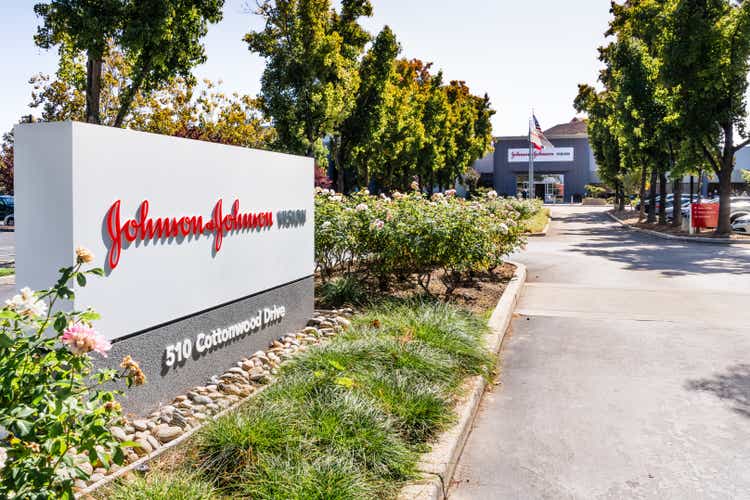Sundry Photography/iStock Editorial via Getty Images
Only a handful of governments, not to mention companies, can claim having a AAA credit rating. Johnson & Johnson (NYSE:JNJ) has been one of the few lucky ones to have claimed this trophy rating that demonstrates superior financial strength. At some point, J&J had even a stronger credit rating than the United States government, when the US credit rating was downgraded to AA+ in 2011 and 2013. Johnson & Johnson’s unique credit rating has served well not only its creditors but also its shareholders.
In the past 10 years, the share price tripled, and the company is among the largest ten companies in the United States, with a current market cap of USD 450 billion. Sales are today 50% higher than they were 10 years ago. Cash generation has been consistently superior over the past five years. Things could not be any better.
What has Johnson & Johnson been doing right?
Well, quite a lot. To start with, J&J has not been sparing any money on innovation in its core pharmaceutical business. The company is ranked second globally in R&D investment, has closed a whopping 147 innovation deals in 2021, made 20 new equity investments in 2021 to strengthen its new medicines pipeline, and has launched 20 new major products under its medical equipment division in 2021. It has currently another 50 transformational medicines expected to be launched through 2025, which will continue to power growth and profitability going forward.
Sales revenues have grown by a fifth in the past five years, growing consistently each year. Profitability growth has been growing at a faster pace than sales – a third in the growth of adjusted earnings per share in the past five years – creating significant value for shareholders. As a result, long-term shareholders have been rewarded by average annualized returns of 13.2% and dividend increases that have been consistent for 60 years.
Are the good times likely to continue for J&J?
J&J is set to lose some of its diversification benefits through the planned spin-off of the consumer healthcare business. The consumer business was the smallest contributor to profitability among the three main segments – pharma, equipment, and consumer. With only 22% adjusted income before tax to sales, its profitability margin is half that of the pharmaceutical sector, so spinning off consumer healthcare could be justified for raising the overall profitability of the rest of J&J.
But even with the spin-off, J&J will remain more diversified than most of its peers, as it has limited reliability on one specific drug, a handful of drugs, or even a specific segment – as most of its competitors do. Excluding the consumer segment from the picture, the largest contributor to sales revenues in 2021 was the Immunology pharma segment, with 21%, Oncology followed with 19%, and the rest is quite diverse. The medical devices business contributed 27% of the total revenues, and consumer healthcare only 14%. In that respect, spinning off consumer healthcare will not make J&J a significantly smaller company, although it would reduce its diversification attributes.
The group has been focused on expanding its biggest money maker – the pharma division. With the equity investments and innovation deals that J&J has been expanding, the group has followed peers by venturing into the fast-emerging Chinese biotech sector through partnerships. This is wise, given the exponential growth of biotech in China over the past few years.
J&J’s performance for the near future remains predictable and provides investors with valuable stability in the current global economic turmoil. Adjusted operating sales are expected to grow by a decent 6.5%-7.5% this year, with adjusted EPS growing by up to a tenth.
Reputational and litigation risks will linger
J&J faced one of the most serious challenges to its business and its reputation in the past few years. Tens of thousands of customers claimed that J&J’s cosmetic talc powder was related to cancer. As a reaction, J&J moved its talc business to a separate subsidiary, spending USD 1.4 billion in the process, to ring fence the potential claims and separate them from the rest of the business of J&J. While this can protect J&J (and the shareholders) financially, it has not been protecting it reputational wise, as it is seen as a way to circumvent the system to escape its responsibilities. J&J’s management should remain fully liable.
More discount on JNJ’s valuation will make entry more appealing
J&J’s shares could be seen as fairly valued. At a P/E of 23 times, it lies in the middle of the range between peers. GSK (GSK), with also a large consumer healthcare division that is about to be spun off as well, is trading at 17 times P/E versus. UK group AstraZeneca (AZN) recorded net losses in 2021 yet its market cap is USD 180 billion. Pfizer (PFE) is trading at only 11 times, with also a 32% stake in the consumer healthcare business of GSK, but much of Pfizer’s valuation incorporates its COVID-19 vaccine whose earnings are expected to contract to normal levels going forward. And Denmark’s Novo Nordisk trades at 37 times.
J&J also lies mid-way when it comes to dividend yield, with a current dividend yield of 2.6%. GSK’s and Pfizer’s are 3%, 1.3% from Novo Nordisk and 2% from AstraZeneca.
So hovering around a record high share price, J&J’s current valuation is not cheap compared to peers, and market sell-off in the past months did not impact J&J’s share price – rightly so, as investors shifted from more risky sectors to J&J and its peers. Further discount to the shares that could develop from the continuation of the mass sell-off in markets could help open an enticing entry for new investors.


Be the first to comment